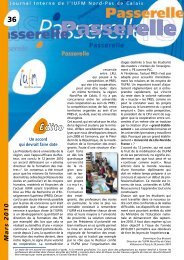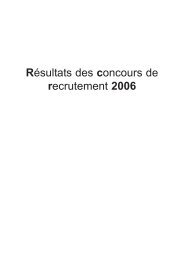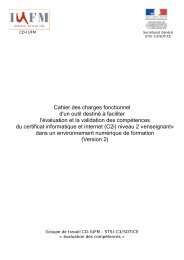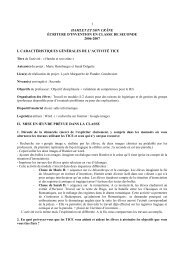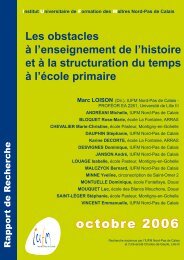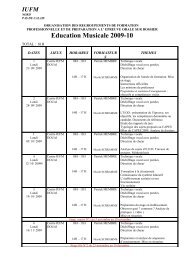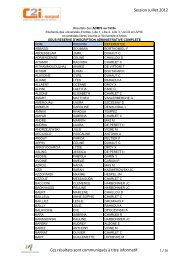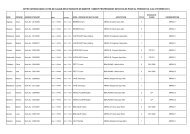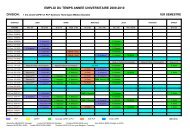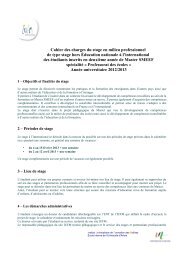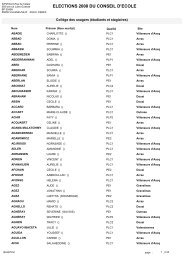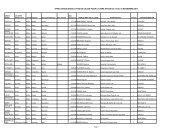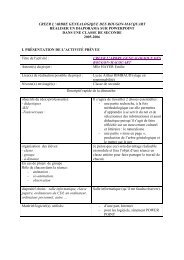Create successful ePaper yourself
Turn your PDF publications into a flip-book with our unique Google optimized e-Paper software.
discriminate between the variab<strong>le</strong>s studied. To study the relations between S.I.A. and the<br />
didactics of mathematics consequently questions the theoretical status that mathematics<br />
didacticians can grant to these models of ru<strong>le</strong>s as well as the nature or the status of data<br />
from which the modalities of variab<strong>le</strong>s subject to the S.I.A. are constructed.<br />
If one can define mathematical didactics as a plan of scientific study of the phenomena<br />
tied to the transmission of disciplinary know<strong>le</strong>dge, this has the consequence that the<br />
didacticians’ preferred field of observation is that of the mathematics class : the mathematics<br />
class in the sense of the material space, certainly (as there one can explore the posters,<br />
the students’ notebooks…) but also in the sense of symbolic space (the mathematics class<br />
still exists when the teacher prepares his classes, when the student <strong>le</strong>arns his <strong>le</strong>ssons, at<br />
home, at study…). This class exists consequently once the interactions between subjects<br />
places them one as teacher, the other as student, in relation to an object of disciplinary<br />
know<strong>le</strong>dge. Very schematically, one of the princip<strong>le</strong> objects of study of didactics is that of the<br />
manifestations of this relationship between these three interdependent e<strong>le</strong>ments, the master,<br />
the student and the know<strong>le</strong>dge of the discipline, of its establishment and its maintenance<br />
over time. Two consequences can be drawn from this modelling. Firstly the observab<strong>le</strong>s<br />
are consequently constructed as interactions between master and student, master and<br />
know<strong>le</strong>dge, student and know<strong>le</strong>dge. Then this study requires the analysis of the regulations<br />
that are simultaneously going to be generated by this system of interactions and assure its<br />
functioning. Thus for examp<strong>le</strong>, one of the most fruitful prob<strong>le</strong>ms in mathematical didactics is<br />
that of the regulations which affect the interactions between the student and the know<strong>le</strong>dge<br />
at issue if the observab<strong>le</strong>s are in this case actions in which the student is engaged (linguistic<br />
or not), the regulations that govern these actions the engagement of procedures, some<br />
choices made…) or that are produced by these actions (the abandonment of certain ways<br />
of acting, certain controls…) are essential to highlight.<br />
Some of the ru<strong>le</strong>s made evident or revea<strong>le</strong>d through I.S.A. are thus interpretab<strong>le</strong> in<br />
mathematical didactics in terms of regulation of interactions. Two positions can then be<br />
adopted : either these ru<strong>le</strong>s have the status of hypotheses for the didactician, it being his<br />
responsibility to invalidate them or confirm them through other methods of analysis (as for<br />
examp<strong>le</strong> the undertaking of interviews) or they have the status of facts of experience (thus<br />
allowing to contradict or not invalidate the analysis a priori).<br />
The asymmetry that these ru<strong>le</strong>s present is also to be taken into account in the interpretation<br />
that mathematical didactics can make of them. It poses the prob<strong>le</strong>m of asymmetries<br />
explicab<strong>le</strong> by the modelling in terms of a system of interactions. The didactic system that we<br />
have summarily evoked (a trip<strong>le</strong>t of interactions between student, teacher and know<strong>le</strong>dge)<br />
is a system in which the dissymmetries of the characteristics tied by a ru<strong>le</strong> can be explained<br />
in a number of different ways.<br />
Let us begin with the most classic case, in which the ru<strong>le</strong>s established are from data<br />
corresponding to situated observab<strong>le</strong>s the actions or the effective declarations of students<br />
or teachers gathered on site). A dissymmetry between observab<strong>le</strong>s must correspond to the<br />
dissymmetry between modalities of variab<strong>le</strong>s linked by a ru<strong>le</strong> which has resulted from S.I.A.<br />
‘all the subjects having the characteristic A have the characteristic B’. This dissymmetry<br />
<strong>le</strong>ads to question didactically the fact that very few students have done B without having<br />
done A, have succeeded in B without having succeeded in A, have answered B without<br />
having answered A, that very few teachers have done B without having done A etc. These<br />
regulations of doing, saying and of their effects can be the effects of temporality, of differences<br />
between the tasks proposed, of organization of know<strong>le</strong>dge…<br />
106<br />
<strong>IUFM</strong> Nord-Pas de Calais




